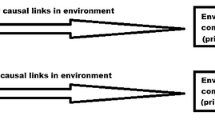Abstract
The necessity of the impact assessment phase in life-cycle assessment (LCA) is presently debated. The crux of the debate lies in the poor accordance in some I.CA studies between the predicted environmental impact and the expected occurrence of actual environmental impact. That is in particular the case for impacts of a continental, regional and local character. We consider an impact assessment as being an indispensable phase of LCA, and see options for solving the identified problem. This article takes a closer look into the nature of the assessed impact in LCA in order to provide the basis for enhancement of life-cycle impact assessment. LCA is one of the analytical tools to support environmental policy focused on the control of present environmental problems. Nowadays, environmental problems are caused by concentration levels that result from the emissions of many sources together, rather than from single sources alone. The contribution from a single source is usually small or even marginal in comparison with the total contribution from all sources together. The multiple source character of the related impact categories provides the justification for the linear nature of the assessed impact in LCA. An article in the next issue of this journal will build further on this article, and will discuss the inclusion of temporal and spatial aspects (by a site-dependent approach) in order to enhance the accordance between the predicted environmental impact and the expected occurrence of actual environmental impact.
Similar content being viewed by others
References
Berdowski, J.J.M.; R.J.K. van derAuweraert; P.F.J. van derMost;C.H.A.Quarles vanUfford; O. Van deVelde; E.A.Zonneveld: Emissions in The Netherlands. Trends, themes and target groups 1993 and outlooks to 1994. No. 26 of publication series of emission registration. The Netherlands, The Hague, Ministry of housing, spatial planning and environment, 1995 (in Dutch)
Consoli, F.; D.Allen; I.Boustead; J.Fava; W.Franklin; A.A.Jensen; N. deOude; R.Parrish; D.Postlethwaite; B.Quay; J.SiÉguin; B.Vigon (eds.): Guidelines for life-cycle assessment. A code of practice. Belgium, Brussels, SETAC-Europe and SETAC-USA, 1993
Daalmans, R.: LCA Excursions along the road to appropriate use. LCA-News from SETAC-Europe, vol. 5 (1995), issue 4, pp. 1–2
Fava J.; F.Consoli; R.Denison; K.Dickson; T.Mohin; B.Vigon (eds.): A conceptual framework for life-cycle impact assessment. Belgium, Brussels, SETAC-Europe and SETAC-USA, 1993
Giegrich, J.: Personal communication, Jürgen Giegrich, Institut fur Energie- und Umweltforschung, Heidelberg, Germany, 1996
Heijungs, R.; J.GuinÉe; G.Huppes; R.M.Lankreijer;H.A. Udo deHaes; A.Wegener Sleeswijk A.M.M.; A.M.M.Ansems; P.G.Eggels; R. VanDuin; H.P. deGoede: Environmental life cycle assessment of products. Guide and background, ISBN 90-5191-064-9. The Netherlands, Leiden, Centre of Environmental Science of Leiden University, 1992
Hogan, L.M.; R.T.Beal; R.G.Hunt: Threshold inventory interpretation methodology. A case study of three juice container systems. International Journal of Life Cycle Assessment, vol. 1 (1996), issue 3, pp.159–167
Jager, D.T.; C.J.M.Visser (eds.): Uniform system for the evaluation of substances (USES), version 1.1. Distribution no. 11144/ 150 (in Dutch). The Netherlands, The Hague, Ministry of Housing, Spatial Planning and the Environment (VROM), 1994
Jolliet, O. (ed.); J.Assies; M.Bovy; G.Finnveden; J.B.GuinÉe; M.Hauschild; R.Heijungs; P.Hofstetter; J.Potting;H.A.Udo deHaes; N.Wrisberg: Impact assessment of human and ecotoxicity in life cycle assessment. In: Towards a methodology for life-cycle impact assessment. Belgium, Brussels, SETAC-Europe, 1996
KlÖpffer, W.: Reductionism versus expansionism in LCA. The international journal of life-cycle assessment, vol. 1 (1996), issue 2, p. 61
Langeweg, F. (ed.): Sorrow for tomorrow. National environmental outlook 1985-2010. The Netherlands, Bilthoven, National Institute of Public Health and Environmental Protection, 1989
NEPP: National Environmental Policy Plan. To choose or to lose. The Netherlands, The Hague, SDU-uitgeverij, 1989
Owen, J.W.; S.P. Rhodes: Discussion paper on the feasibility of developing characterisation models for various impact categories. Submitted to ISO TC207/WG4 on behalf of the USA delegation. May 1995
Perriman, R.J.: Is LCA losing its Way? LCA-News from SETAC-Europe, vol. 5 (1995), issue 1, pp. 4–5
Potiing, J.; K.Blok: Life-cycle assessment of four types of floor covering. Journal of cleaner production, vol. 3 (1995), issue 4, pp. 201–213
Potting, J.; K.Blok: Spatial aspects of life-cycle impact assessment. In: Integrating impact assessment into LCA. Proceedings of the LCA symposium held at the fourth SETAC-Europe Congress, 11-14 April 1994 at the Free University of Brussels in Belgium. Belgium, Brussels, SETAC-Europe, 1994
Potting, J.; B. TorgiusMùller; A.A.Jensen: Work environment and LCA. LCANET Theme report. The Netherlands, Leiden, LCANET, 1997
PPE: Policy document on products and the environment. The Netherlands, The Hague, Dept. for Information and International Relations of the Ministry of Housing, Spatial Planning and the Environment, 1994
Schmidt, A.; B.H. Christensen; A.A. Jensen: Environmentally friendly stoves and ovens (in Danish with English summary). Environmental Project no. 338, Danish Environmental Protection Agency, Denmark, Copenhagen
Udo deHaes, H.A. (ed.).; M.Bovy; K.Chistiansen; G.Finnveden; R.Frischknecht; J.Giegrich; J.B.GuinÉe; M.Hauschild; R.Heijungs; P.Hofstetter; A.A.Jensen; O.Jolliet; E.Lindeijer; R.MÜller-Wenk; Ph.Nichols; J.Potting; H.Wenzel-Christensen; P.White: Discussion of general principles and guidelines for practical use. In: Towards a methodology for life-cycle impact assessment. Belgium, Brussels, SETAC-Europe, 1996
Weidema, B.P. (ed.): Environmental assessment of products. A textbook on life cycle assessment; 2nd edition. Sweden, Helsinki, UETP-EEE, 1993
Wenzel, H.; M.Hauschild; L.Alting: Environmental assessment of products—methodology, tools & techniques, and case studies in product development. Chapman and Hall, United Kingdom, 1997
White, P.; B. DeSmet;H.A.Udo deHaes; R.Heijungs: LCA back on track, but is it one track or two? LCA news from SETAC-Europe, vol. 5 (1995), issue 3, pp. 2–5
Author information
Authors and Affiliations
Rights and permissions
About this article
Cite this article
Potting, J., Hauschild, M. Predicted environmental impact and expected occurrence of. Int. J. LCA 2, 171–177 (1997). https://doi.org/10.1007/BF02978815
Issue Date:
DOI: https://doi.org/10.1007/BF02978815




